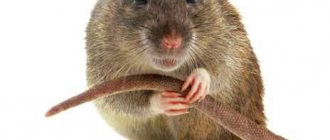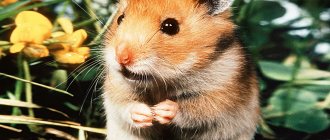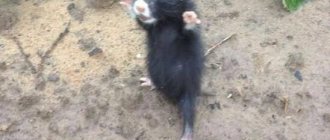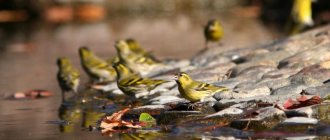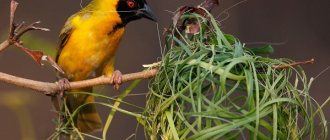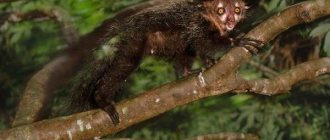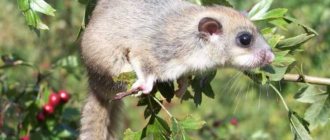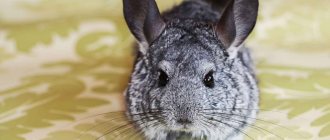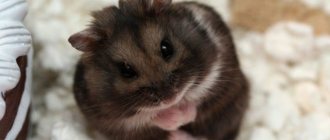- October 27, 2018
- Miscellaneous
- Michael
Not every summer resident has encountered karbysh. But those who have such misfortune will not soon forget about such contact. After all, a couple of these pests, finding themselves in a large area, may well leave a summer resident without the harvest he worked on all summer. Therefore, you have to fight the little carbysh animal, the photo of which is attached to the article, as decisively as possible, without the slightest compromise. Otherwise, instead of a rich harvest in the fall, you will get, at best, a mountain of cores.
Appearance
First of all, it is worth noting that this animal belongs to hamsters, being a representative of a rather harmful family. As you can see in the photo, the carbysh animal really looks like other rodents of this species.
- Its color is quite bright, even beautiful.
- The back is yellowish-brown, the belly is black, and the sides are decorated with large white spots. At the same time, the coat is short, but thick and pleasant to the touch, very soft.
- The ears are quite massive and stand out sharply on a neat head.
- The paws are quite wide with thin, sharp claws, which allows the carbysh to dig deep holes in which it will live, store supplies for the winter and raise offspring.
The karbysh is one of the largest hamsters - its weight can reach 750 grams! At the same time, the body is quite dense, compact, up to 35 centimeters long.
How to choose a rodent for an adult?
Before purchasing a rodent for home keeping, there are several factors to consider:
- Apartment size. It should be clear that you cannot bring a large pet into a small apartment, but on the contrary, you can.
- Price. Before you get a rodent, you need to calculate the approximate cost of keeping it so that there are no unwanted surprises later.
- Possible difficulties. Animals should not be owned by people who do not need unnecessary problems and troubles around the house. For example, regular hair removal or cage cleaning.
- Allergy test. You need to find out if someone is allergic, so as not to get into an unpleasant situation.
- Lifestyle. Rodents are mostly nocturnal animals. We must honestly answer the question: “Will this stop me?”
In conclusion, it must be said that each person selects an animal to suit his lifestyle and temperament. Who, no matter how small a creature, will instill love and make you smile?
Lifestyle
Now you know what carbysh looks like - photos make it easy to identify this harmful rodent. This means it’s time to find out about his habits and lifestyle.
Although the karbysh is a wild animal, it still prefers to live closer to humans: in vegetable gardens, garden plots, arable land, and parks. Which is not surprising - the soil here is loose, which means it’s easy to dig a hole. But more importantly, there is always something to eat near a person.
The burrows these rodents dig are very deep and long. The depth of some reaches two meters, and the length, taking into account all the branches, is 5 meters. Here they live, winter, raise their young, and store supplies collected in the fall.
At the same time, karbysh are owners and loners. They never live in packs, preferring a solitary lifestyle, gathering in pairs only during mating. When a guest climbs into someone else's hole, an extremely brutal fight with the owner will begin, which usually ends, if not with the death of one of them, then at least with serious injuries.
They are most active at night. It is in the dark that the carbysh actively moves, feeds, and stores. During the day, he prefers to sleep in his hole, practically without leaving it, or being in close proximity to his home in order to have time to hide.
It feeds mainly on plant foods: root crops, cereals, young grass. But on occasion he does not refuse the animal. Thus, its diet is often supplemented by worms, even mice, lizards, frogs and small snakes, and insect larvae.
Pros and cons of keeping rodents
pros
These include the following facts:
- inexpensive maintenance and minimum hassle;
- unpretentious care that any child can handle;
- these are very clean animals, so there will be no need for constant bathing;
- they do not make loud sounds and do not interfere with sleep;
- rodents are quite intelligent and easily amenable to simple training;
- There is nothing expensive that rodents eat: mainly special food, hay, vegetables, fruits, and various vitamins.
Minuses
The disadvantages include:
- many species do not live long - about 2-5 years, but the exceptions are chinchillas and rabbits, whose age can reach 12-15 years;
- the animal should not be allowed out of the cage if there is no one to look after it, otherwise the house will be a mess;
- the cage needs to be washed every day so that there is no strong smell in the apartment;
- small animals must be handled carefully, otherwise they may bite;
- can make sounds at night, since at this time of day they are most active.
This article talks about what types of domestic rodents are with photos and names.
Habitat
The habitat of the carbysh animal, the photo of which you have already seen, is quite large. For example, in Europe it can be seen in Germany, France, Poland, Belgium, the Netherlands, Belarus - in all these countries it is protected, as it has been practically exterminated.
In our country, it lives from the northern border of the Perm Territory to Smolensk. Also, summer residents from Krasnoyarsk to Yekaterinburg often complain about it. There is quite a lot of it on the coast of the Black and Azov Seas. It is found in Kazakhstan - mainly in the east and north, where agriculture is most developed.
A new novel in the personal life of Dmitry Khrustalev
After breaking up with his common-law wife, Khrustalev began a new romance - with Ekaterina Varnava
Due to the fact that they worked together and communicated a lot on stage, few people paid attention to the beginning of a romantic relationship between the two colleagues; moreover, they diligently hid it. Katya admitted that she fell in love with Khrustalev when she did not yet know him personally, but only watched his performances as part of the KVN team
In the photo - Dmitry Khrustalev and Ekaterina Varnava
When they started working together at Comedy Woman, at first love was played out only on stage, and Varnava did not take Dmitry’s words seriously when he said that he could become an ideal husband for her. They became increasingly imbued with mutual sympathy, and after six months of relationship they began to live in the same apartment.
At that time, Khrustalev was already free, and nothing stopped him from changing something in his personal life.
However, Katya remained Dmitry Khrustalev’s common-law wife for no more than a year - living together turned out to be not so easy, quarrels began to break out more and more often between the lovers, and Varnava, tired of constant strife, went to live with a friend, and Mitya said that they would have a better life apart. Both claimed that the feelings between them had not passed, but they never managed to reunite again.
What harm does it cause to the garden?
Throughout the warm season, karbysh actively feeds. Moreover, he happily eats cereals, gnaws beets, radishes and carrots, destroys crops of young peas, eating sprouts. In general, he is not particularly picky, so the list of his “victims” may include cucumbers, tomatoes, pumpkins, onions, squash and much more. The animal does not shine with intelligence, so it gnaws on almost everything that seems at least somewhat appetizing to it. Often he simply spits out the food he doesn’t like, but the vegetable is already spoiled!
Karbysh often sharpens its teeth on the bark of young fruit trees and shrubs, mercilessly tearing it off, which quite often leads to the death of the plant, which took several years to grow.
In the fall, he begins collecting supplies for the winter. Here he gives preference to cereals. Their karbysh, like all other hamsters, carries them around in cheek pouches. In just a few weeks, a seemingly small animal can create a reserve of up to 15 kilograms in its burrow! And this is just one rodent.
But a couple of carbysh that appear on the site will quickly turn into several dozen. After all, if there is food, the female gives birth to cubs every month and a half. Moreover, the litter can contain 10–12 cubs. Just imagine how many pests will end up in your area if you don’t take emergency measures. If you leave everything to chance, hoping that the problem will be solved on its own, then in the fall you will definitely not see the harvest - it will be eaten or simply spoiled by harmful rodents.
Tundra
Fauna of Australia
Only those birds that do not require lush vegetation live in the tundra zone. They also perfectly adapted to the cold, difficult climate. The natural conditions of the tundra are frequent hills, an abundance of swamps, small ponds, as well as many lichens and mosses. The tundra and arctic zones border each other, so the bird fauna has common features.
Tundra of Russia
polar owl
The polar or snowy owl is the largest inhabitant of the tundra among all owls. It is distinguished by its completely white color with small dark spots, although the chicks are born brown. Females are larger than males. The polar owl is a nomad and an active predator.
Polar Owl Interesting fact: the image of the polar owl is used in many industries. For example, in cinema and animation. This bird is also depicted on several coats of arms and is a symbol of the Canadian province of Quebec.
Bunochka
Representative of the order of Crows. The bunting weighs only about 30 g with a body length of 16.5 cm. Males and females differ in color, especially during the mating season. Males are usually black and females are white. Both have light bellies. Buntings feed on insects in summer and grains in winter.
Bunochka
Danger to humans
By the way, you shouldn’t be moved by looking at a photo of a karbysh. The animal is, of course, very beautiful. But it is not just a pest, but also poses a danger to humans.
Some people, having noticed this hamster on their site, decide to catch it. And as a result, they pay with their own health. A carbysh driven into a corner behaves no less cunningly and aggressively than a rat. Moreover, these rodents are often carriers of various infections. Therefore, a bite can cause a serious illness, the cure of which will take a lot of time and effort. Keep this in mind before you attack a rodent with your bare hands. No, this is a real war. And it must be carefully planned and thought out in order to achieve the desired result.
Predator birds
There are many small predators in the forests and fields of the region. They are food for birds of prey, both diurnal and nocturnal.
You can recognize a buzzard hovering over a field by its short and rounded striped tail, as well as by the lighter color of its wings in the lower part. In flight, birds communicate with each other using a loud and drawn-out cry “kiya”. The main diet of the predator consists of rodents.
This formidable predator can be distinguished in flight by its forked tail. The bird's favorite food is fish, which it grabs with its claws. At the beginning of spring, the kite feeds on thawed carrion, protecting the forest from the spread of infectious diseases.
The owl’s “ears” are two tufts of feathers, which it can make invisible by pressing them to its head. The color of the bird is similar to the color of the bark of pine trees; a bird clinging to a tree can easily be mistaken for a branch. The owl is a nocturnal hunter whose main food is mouse-like rodents. Watch how ornithologists from the Nizhny Novgorod region ring birds.
Fight against carbysh
The only bloodless and humane way to get rid of a rodent is to use special sound repellers. You can buy them in special stores. A person practically does not hear the sound they make, so all residents can calmly go about their business. But it has a more depressing effect on the carbysh, and as a result, after a few days the rodent leaves its usual habitat. The only negative is that this technique does not always work. The reason for this is unknown - either not all repellers are equally effective, or some animals are immune to them.
Therefore, we often have to resort to less humane methods - traps and poisons.
Traps (or large rat traps) are installed near the found exits from the holes. Be careful - one tunnel can have 4-5 exits. You can also place poisoned baits near the minks - poison can be easily purchased at any store for summer residents.
Yes, it's cruel. But in the battle for the harvest one cannot be too humane.
Small rodents
Mice
It should be borne in mind that these are herd animals, so it is better to keep several individuals. If this is not possible, you need to arrange the cage in such a way as to prevent your pet from getting bored - for example, install a running wheel. Mice are easy to care for, but do not live long - about 2 years. They are omnivores, but you cannot overfeed them, otherwise it will harm your health. The main disadvantage of mice is their pungent odor, but this disappears with regular cleaning of the cage.
Rats
Rats are very smart animals. They are friendly, quickly get used to new conditions, and can also remember some commands. With proper care they live 2-3 years. Just like mice, they are omnivores. Rats are active - it is important to let them walk outside the cage. If you want to have this pet, you need to be absolutely sure that the animal will be given a lot of attention, otherwise it will not survive. The disadvantages also include a strong smell, but with good cleaning it quickly disappears.
Gerbil
It is better to keep such mice in families - loneliness can lead to illness. They are clean, peaceful, and easy to train. The length of the gerbil reaches 20 cm, and their color is light sandy. Since mice are very active, a running wheel should be placed in the cage. Gerbils love to grind their teeth - disinfected twigs and pieces of wood will do. They practically do not smell - the cage should not be washed more often than once every 2 weeks. They live 2-4 years, but sometimes the age can reach 6 years.
Hamsters
The most common breed of rodent suborder is the Djungarian hamster. These are nocturnal animals whose peak activity occurs at night. Hamsters are quite aggressive - it is dangerous to add a cage mate to them, otherwise everything will end badly. It will take a long time to tame the pet; in the worst case, it will bite painfully. They do not live long - maximum 2-3 years. They require a little attention and eat special food. There is no need to skimp on the things you need to keep your pet. Standard set: cage, food bowl, water bowl, house, running wheel, food.
Guinea pigs
Features of caring for a guinea pig depend on its breed. They are quite affectionate and non-aggressive, often becoming attached to their owner. They are unpretentious in home care - you will need a spacious cage, corn filler, a drinking tube, and bowls. Since the body of pigs does not produce vitamin C, which is necessary for the immune system, it is necessary to buy vitamins containing ascorbic acid. The average lifespan is 5-8 years, but there are also those who reach 15 years. It is recommended to walk with the animal in the fresh air. They are herbivores, so they should be given hay and dry food for food.
Squirrels
A common breed of domestic squirrel is the Veksha. You need to purchase a spacious cage for the animal with several floors. There must be a running wheel to expend energy reserves. It is better to feed such pets with nuts, fresh fruits, mushrooms, and grain food. They need to get a dose of calcium and phosphorus, which are lacking in the body. Squirrels are clean, so you need to clean the cage no more than 1-2 times a week. If you want to start mating these animals, it is better to do this from one year old. With proper care, the lifespan reaches 10 years, rarely 16.
Degu
The breed has two different names - Chilean squirrel and bush rat. They should be kept in a cage with a dense lattice or in a terrarium. The cage is equipped with a wooden house, a wheel and an entertainment area for the animal. Degus feed on fresh greens, fruits, plant seeds, and in winter, hay. Giving sugar is strictly forbidden, since animals are intolerant to it. It is better to keep them in pairs - loneliness has a bad effect on their health. It is important to keep the animal away from sweets and flowers - this is dangerous for it. Lives on average up to 9 years.
Chipmunks
Chipmunks belong to the squirrel family. The cage for the animal should be large and with all the amenities. It must be borne in mind that chipmunks do not get along well together, so they cannot be kept in pairs. They eat almost everything: fruits, plants, fish, insects, etc. These rodents are quite affectionate, but will bite hard if you touch their belly or tail. Life expectancy is up to 8 years. In winter, they sleep more often, without leaving the house for a long time. They tolerate heat very poorly - if the temperature is above 27 C, they can die.
Jerboa
There are more than 25 species of jerboas. The rodent needs to be kept in a spacious enclosure so that it moves a lot. The cage should not be filled with hay - only with coarse sand. They eat vegetables and fruits, as well as various insects. These are clean animals, so cleaning the cage once a week will be enough. They cannot be kept in pairs - this will lead to fights. They lead a predominantly nocturnal lifestyle. With proper care they live for about 4-5 years.
Sonya
A common breed is the hazel dormouse. To maintain a house, a large enclosure with a suitable landscape is suitable: moss, peat, branches. It is necessary to take care of a place for hibernation - it can be an artificial hole or a small pipe. Dormouses feed on what grows on trees: seeds, nuts, small insects. Their peak activity occurs at night, so it is better to remove the cage from the bedroom. They quickly get used to their hands and remember their nicknames. It is not recommended to let him out for a walk around the house - he will hide in some crevice. Life expectancy is 4-5 years.
Prevention of pest occurrence
If you do not want carbysh to start up on your site, you should get a dog or a rat-catcher cat. These animals will do an excellent job of protecting against dangerous rodents. After all, they perceive them exclusively as tasty and desirable prey.
Of course, if you choose this method, then the use of poisons is out of the question - your pets may well be poisoned by them.
How to choose a rodent for a child?
In order to instill a love for small creatures, children are often given rodents as pets. But before purchasing a pet, you must take into account the age of the child. It is important to remember that under 3 years of age no animals should be owned under any circumstances, since at this time the baby is actively learning about the world around him and can cause significant harm. For example, he will show unwanted care by feeding the animal food that is dangerous for it. To prevent this from happening, parents need to raise their child more strictly, explaining what is good and what is bad. From about 5 years old, you can think about buying a pet rodent.
Wild hamster burrow
The wild hamster is a very clean rodent. His residence is divided into separate rooms, each of which has its own purpose. He sleeps in one part and uses the other part to store food supplies. The floor of the hole is always covered with dry grass, which the animal regularly changes when it gets dirty.
This is how we live.
Ultrasonic repellers
Another effective tool that helps remove carbys from the area is a rodent repeller. This method of pest control is the most humane and safe. The device emits high-frequency ultrasonic waves, the frequency of which changes at a speed of 60 times per second. For rodents, the sound produced becomes unbearable, and they try to move to another territory without a hostile sound signal. The following devices are especially popular:
- "Typhoon". Can be used over an area of up to 220 m. Operates with a wide sound beam. Works in two modes: silent and sound. The first is used in residential premises, the second is more effective and is used where people do not live.
- "Grad". It works silently. Emits simultaneously sound and ultrasonic waves. There is a built-in flickering beam.
- "Electrocat" The rodent repeller acts not only with sound waves, but also with light flashes. There is a special irritating signal that has the most effective effect on rodents.
To achieve better results in the fight against underground pests, some gardeners bury an ultrasonic device in the ground and turn it on. According to them, karbysh leave the garden plot in a short time.
Reptiles Edit
Unlike the common viper and grass snake, which are ubiquitous, the steppe viper and spotted snake are found only in the southern regions of Bashkiria. The godwit lives in forest and forest-steppe zones.
The European marsh turtle inhabits water bodies in the southern regions of the republic: Baymaksky, Kuyurgazinsky, Kugarchinsky, Meleuzovsky, Zianchurinsky, Zilairsky and Khaibullinsky districts. The marsh turtle lives in slow-flowing and stagnant bodies of water [17].
The Red Book of Bashkiria includes such rare species as the legless lizard - the spindle, the gray snake - the common copperhead, the water snake, the patterned snake, the steppe viper and the marsh turtle [18].
Conservation status
The number of the species has declined sharply over the past 20 years and continues to decline, but mainly only in the west and north of its range. Western European countries have adopted national programs for the conservation of this species.
The common hamster is protected in France, Belgium, the Netherlands, Germany, Poland, and Belarus.
In 2009, it was included in the Red Book of Ukraine, and by 2012, in the Autonomous Republic of Crimea, the animal was causing significant damage to the agriculture of the peninsula, including suburban farms.
On the territory of the Russian Federation it is protected in 5 constituent entities of the federation. A decrease in the number of the species has also been noted in other regions of the European part of Russia.
The hamster population is stable in Kazakhstan and Siberia, where during years of population growth it can cause harm to agriculture.
In recent years, the number has increased in the Azov district of the Rostov region, in the Krasnodar Territory, as well as in the Crimea, where the hamster also causes significant damage.
Flora of St. Petersburg
St. Petersburg is located at the southernmost tip of the taiga zone. Many thousands of years ago, a huge sea lay imposingly here, lazily rolling its blue waves under the influence of the wind. Then this area was covered by a glacier, which, crawling away, took with it the sea plain. All that was left of the sea was the Neva, a river in whose delta a huge number of islands formed. It was on them that Tsar Peter erected the first buildings of the future city. The swamps were urgently drained, and piles were pre-installed for the construction of many buildings. The piles were made from larch, which is known for the fact that it does not rot in water, and over time it becomes harder than stone.
Already 4 thousand years ago, the taiga encroached on these places. Its firs, spruces and pines approached the Gulf of Finland in a dense ring, interspersed only in the very south with tall bushes. Therefore, the flora of the city is presented in a very unique way. In the northern regions of the city, centuries-old pines and spruces still flourish, and in the south, ordinary people collect blueberries, lingonberries and sorrel.
Now St. Petersburg can be called one of the greenest cities in Russia. Vegetation covers up to 40% of the city's total area. Meticulous statisticians have calculated that until recently there was up to 65 sq.m. per St. Petersburg resident. green spaces. And no wonder, because the city has 68 parks, more than 150 gardens, over 700 public gardens and about 200 boulevards.
Natural forest vegetation has been preserved in many parks and gardens of the city: in Piskarevka, Sosnovka, near the Technical University and the Forestry Academy.
The vegetation of St. Petersburg is best represented in its parks. So in Central Park. S. Kirov, that on Elagin Island you can see 200-year-old oaks and elms, maples and birches, which coexist peacefully with centuries-old pines and firs. This is the northernmost park of the city, which very clearly demonstrates the proximity of taiga and deciduous forests.
The Summer Garden is the favorite brainchild of Peter I, who became one of the first parks in the capital of the empire, laid out according to all the rules of horticultural art. Over the centuries, the appearance of the garden has changed several times, but even now it remains one of the most visited parks in the city, where you can admire spreading linden and maple trees, numerous shrubs and a beautiful lawn.
Sosnovka Park, in the Vyborg region, is famous for its mighty pine trees. And Yuzhno-Primorsky Park, located in the Krasnoselsky district, delights visitors with slender chestnuts, weeping willows, mighty oaks and beautiful fir trees.
Pesticide
Poison against hamsters
If you have black forest hamsters in your garden, you can use bait for them. The modern market of pesticides offers a variety of poisonous agents for such pests.
From the experience of gardeners, only a few effective means have gained the most popularity:
The poison is mixed with food and water. The poison is then placed near the hamster's hole. For a rodent to try this treat, it must be mixed with a grain mixture, nuts, seeds, and vegetable trimmings.
The poison should be spread in dry weather. In the rain, the poison loses its properties. Poison bait is laid out throughout the area - near the hamster holes and along the paths.
Also, do not forget that such products are dangerous to humans. When laying them around the area, use protective gloves and a mask.
Who are the karbysh?
Karbysh is a common hamster. It is the largest representative of the hamster subfamily. The body length of an adult animal can reach 34 cm, the tail is 8 cm. The average body weight of an animal is 700 g.
The animal has soft and thick hair. The color of the skin can be bright and contrasting. Karbysh can have a reddish-brown color on top, and the belly can be black. On the sides of the front there are two light spots separated by black fur. Light spots may occur on the sides of the animal's head and behind the ears. In nature, there are completely black hamsters.
The muzzle of the karbysh is of moderate length. The tail is wide at the base and tapers towards the end. It is all covered with hard and short hairs. The ears are short, the hand and foot have a wide base. The claws on the fingers are well defined.
The common hamster has a wild and vicious disposition, often turning into aggression. Therefore, carbysh can bite each other. How to deal with them? The best remedy for these animals is a trap. After a hamster bite, lacerations remain on the body, which can be dangerous for both humans and pets. These rodents spread more than 30 types of deadly diseases to humans.
Fauna of the Nizhny Novgorod region
The fauna of the Nizhny Novgorod region is also wide and diverse. A considerable number of representatives of different species live here.
Brown bears, lynxes, wolves and foxes live in forests and places far from humans. There are also moles, hares and squirrels, hedgehogs, muskrats and shrews.
Among the artiodactyls in the Nizhny Novgorod region you can find wild boars, deer, and moose.
Both in forests and in open spaces, there are martens, weasels, stoats and ferrets. Also representatives of small animals in the region are: badgers, otters and minks.
In the fields and meadows there are mice, voles, muskrats and hamsters.
The reservoirs and swamps of the Nizhny Novgorod region are full of inhabitants. Frogs, toads and newts find their refuge here, as well as lizards and snakes.
The region is home to many birds. Birds of prey include falcons, hawks and ospreys.
Herons and storks live in the floodplains, as well as ducks, geese and swans. The steppe zone is suitable for life of crane-like bird species.
The permanent and frequent inhabitants of the area are waders and gulls. Woodpeckers are irreplaceable inhabitants of both forests and steppes of these places.
It is also worth paying attention to the owl species; here you can find both tawny owls and owls. There is a bird here that is almost impossible to notice in everyday life - the black-throated and red-throated loon
There is a bird here that is almost impossible to notice in everyday life - the black-throated and red-throated loon.
Spreading
The common hamster is common in meadow and forest-steppes, as well as in the mixed-grass steppes of Eurasia from Belgium to Altai and Northern Xinjiang.
In Russia, the northern border of the range goes:
- from Smolensk north of Rzhev to Yaroslavl, Kirov and Perm;
- in the north of the Perm region it reaches 59°40′ N. sh.;
- in the Trans-Urals it goes through Yekaterinburg, crosses the Irtysh north of Tobolsk and the Ob in the Kolpashevo region, from where it goes to Krasnoyarsk.
The eastern border is formed by the Minusinsk steppe, where the hamster penetrated relatively recently.
The southern border runs:
- along the Azov and Black Sea coasts approximately to Gagra;
- covers the western Ciscaucasia, goes around the deserts and semi-deserts of the eastern Caspian region and the Volga-Ural interfluve from the north;
- crosses the Volga in the Astrakhan region.
Then it goes to Kazakhstan, where it goes approximately 47° N. w. to the lower reaches of the river Sarysu, covers the northern part of Betpak-Dala, the central and northeastern parts of the Kazakh hillocks, the valleys of the river. Ili and Karatal, the foothill areas of the northern and eastern Tien Shan, the Alakol and Zaisan basins and along the border of western Altai reaches the right bank of the Yenisei near the village. Beya.
Folk remedies
You have a forest hamster in your garden, then folk remedies for fighting it will be of help. We bring to your attention the most effective and proven:
- Take regular ash, pour it into holes and dust the paths made by rodents. As you know, ash is an alkali. As it moves, it will eat away at the skin of its paws. The forest hamster will lick it off. Once inside, this substance corrodes the stomach, resulting in the death of the rodent.
- Grind several wine corks into small crumbs. Pour aromatic oil over them, mix this mixture well and place it near the hole. The oily aroma is very attractive to rodents. A rodent simply cannot refuse such a fragrant treat. The plugs that get inside the stomach begin to swell, resulting in an obstruction in the intestines, and the rodent dies.
- Mix alabaster with wheat flour. Place a couple of spoons of seven near the mink. Place a container of water nearby. After eating the dry mixture, the rodent will certainly want to drink water. By reacting with liquid, alabaster turns into cement. Therefore, the probability of death of the rodent is one hundred percent.
Fauna of Bashkiria
Bashkir horses in the Abzelilovsky district
Fauna of Bashkiria
- a set of living organisms of all types of wild animals that permanently or temporarily inhabit the territory of the Republic of Bashkiria.
The diversity of landscapes and natural zones of the republic, geographical location and historical connections with the European part of Russia and Siberia determined the richness and diversity of its animal world. Bashkiria is home to 120 species of unicellular organisms, about 700 species of worms, 121 species of mollusks, about 5000 arthropods, 47 fish, 10 amphibians, 10 reptiles, about 300 birds, 76 mammals.
Prairie dog cost
The average price of one prairie dog in Russia ranges from 30,000 to 70,000 rubles. In Thailand the price is 150-180 dollars. Animals are very popular!
Other photos of prairie dog:
Video:
Reproduction
All rodents are especially prolific. Karbysh is no exception. Common hamsters breed in March and April. During the season, a female can give birth to about three broods. Each time 8-15 cubs are born. How to deal with them? Karbysh without timely control measures will not leave a trace of crops in the garden. Therefore, it is necessary to take action immediately.
Karbysh animal: photo, description, habitat, harm and control methods
- October 27, 2018
- Miscellaneous
- Michael
Not every summer resident has encountered karbysh. But those who have such misfortune will not soon forget about such contact. After all, a couple of these pests, finding themselves in a large area, may well leave a summer resident without the harvest he worked on all summer. Therefore, you have to fight the little carbysh animal, the photo of which is attached to the article, as decisively as possible, without the slightest compromise. Otherwise, instead of a rich harvest in the fall, you will get, at best, a mountain of cores.
